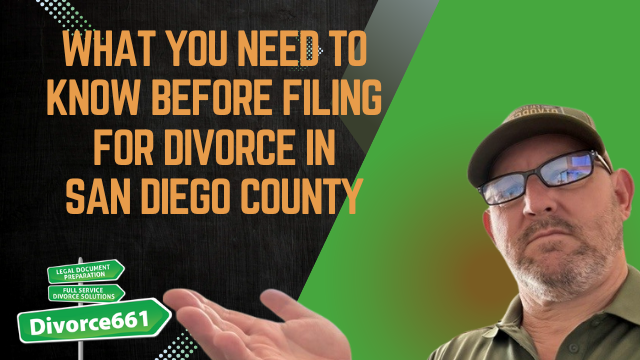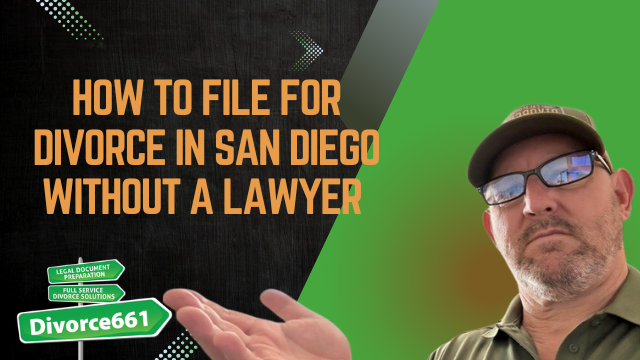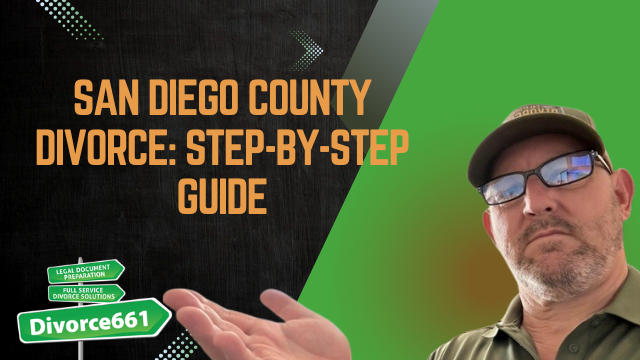Step-by-Step Guide to an Amicable Divorce in San Diego
Hi, I’m Tim Blankenship of Divorce661. If you and your spouse are on the same page and want a peaceful, efficient way to end your marriage in San Diego County, an amicable divorce is the best path. Even when you agree on the major issues, the legal paperwork and procedural steps can be confusing. Below I’ll walk you through the exact step-by-step process I use to finalize amicable, uncontested divorces in San Diego — without court appearances or expensive attorneys.
Overview: What an amicable divorce looks like
An amicable (uncontested) divorce means both spouses agree about the division of assets, debts, support, and parenting arrangements (if applicable). The court’s role is to make sure the agreement is complete and legally enforceable. In California there is one mandatory requirement that can’t be waived: a 6-month waiting period from the date the respondent is served or acknowledges receipt of the divorce paperwork.
Step-by-step process
-
Step 1 — File the petition (start the case)
One spouse must initiate the process by filing the required court forms. In California these commonly include:
- FL-100 — Petition for Dissolution (or legal separation)
- FL-110 — Summons
- FL-105 — Declaration Under Uniform Child Custody Jurisdiction and Enforcement Act (UCCJEA), if you have minor children
In San Diego County, these documents are filed electronically. After filing you’ll receive a case number and a filing stamp showing the official date the case was opened.
-
Step 2 — Serve your spouse (or obtain a signed acknowledgment)
Even when you both agree, the other party must be legally served or must sign a Notice and Acknowledgment of Receipt. This formal service is what starts California’s mandatory 6-month waiting clock. Service is a required legal step — it cannot be skipped just because you agree.
-
Step 3 — Complete and exchange financial disclosures
Financial disclosure is not optional. Both spouses must complete and exchange the following:
- Schedule of Assets and Debts (lists all property, accounts, and liabilities)
- Income and Expense Declaration (details of monthly income and expenses)
Even in amicable cases, these forms must be accurate and complete because the court relies on them before approving your final judgment. Incomplete or inaccurate disclosures can delay final approval.
-
Step 4 — Draft the Marital Settlement Agreement (MSA)
The Marital Settlement Agreement (sometimes called a Property Settlement Agreement) is the document that outlines how you’ll divide assets and debts, whether spousal support will be paid, and how you’ll handle custody, visitation, and child support if there are children.
The more specific and detailed your MSA is, the smoother the court approval process will be. Typical items to address:
- Which accounts and assets go to each spouse (bank accounts, retirement, vehicles, real property)
- How debts will be allocated
- Spousal support: amount, duration, and conditions
- Parenting plan: custody, visitation schedule, decision-making, and child support
- Division of retirement benefits and tax considerations
Both spouses sign the agreement when it’s complete.
-
Step 5 — Prepare and file the judgment package
Once the MSA is signed and all required disclosures are exchanged, you prepare a judgment package (the court paperwork that finalizes the divorce). This includes the signed settlement, judgment forms, any required attachments, and other court-required documents. In San Diego we file everything electronically and monitor the case until the court reviews and approves the judgment.
Because of the mandatory waiting period, the court will not enter a final judgment until at least six months after service. In most uncontested cases where the paperwork is complete and correct, the judgment is approved soon after the 6-month window passes.
Real client example
We recently helped a San Diego couple complete all of these steps in just a few weeks. Their judgment was approved shortly after the 6-month period ended. They never had to set foot in court or hire an attorney — that’s the power of a properly handled amicable process.
“That’s the power of a truly amicable process when handled properly.”
Common mistakes to avoid
- Skipping or improperly completing financial disclosures. The court requires them.
- Vague settlement language. Unclear agreements cause delays or denied judgments.
- Incorrect or missing forms when filing the judgment package.
- Assuming service isn’t necessary because you agree — service triggers the mandatory clock.
Why use a flat-fee, remote service for an amicable divorce?
For amicable, uncontested divorces in San Diego County, a flat-fee remote service can save time, money, and stress. Benefits include:
- All documents prepared and filed correctly
- Electronic filing and case monitoring
- Help with service and disclosures
- A faster, court-free resolution when both parties cooperate
Ready to get started?
If you want a smooth, court-free divorce in San Diego County, visit Divorce661.com to schedule a free consultation. We handle the paperwork start-to-finish so you can focus on moving forward with peace of mind.
Final thoughts
An amicable divorce can be peaceful, fast, and far less expensive than contested litigation — but only if the legal steps are handled correctly. Follow the five steps above: file the petition, serve your spouse, exchange accurate financial disclosures, create a clear marital settlement agreement, and file a complete judgment package. Do those things right, and you’ll be well on your way to a finalized divorce without courtroom drama.










